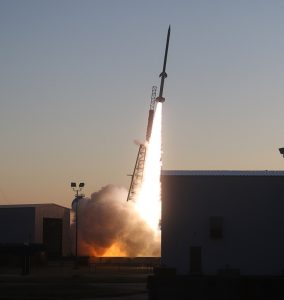HUNTSVILLE – Team TERMINUS from the University of Alabama in Huntsville launched a student-developed payload aboard a Terrier-Improved Malemute sounding rocket that featured two experiments designed by the UAH Space Hardware Club (SHC).

The student packages were launched as part of the NASA RockSat-X program, a flight that soared to an altitude of 100 miles from the NASA Wallops Flight Facility in Wallops Island, Va., before descending by parachute into the Atlantic Ocean for recovery.
According to Ben Campbell, a UAH doctoral student in aerospace systems engineering who founded the TERMINUS Spaceflight Research Group (TSRG), the launch could not have gone any better.
“We have loads of data and are going through it now,” he said, noting that numerous NASA personnel had remarked that the UAH team had produced the best payload in the history of the RockSat program, setting an example for other student teams to strive for in the future.
The UAH payload included a pair of experiments: JUPITER, a custom reusable spacecraft bus-like system that handles all core spacecraft functions and connects experiment hardware with existing launch vehicle electronics, and SwingSat, the smallest satellite tether release ever attempted in space, a project that aims to advance small satellite deployment technologies. The development of the project from start to finish can be seen here in this time-lapse video.
 “The tether system is basically a way to extend some payload out on a tether and rotate it, then let it go. It’s kind of like David and Goliath – it’s got a sling, throws a rock. We’re basically doing that, but with satellites in space,” Campbell said. “This is a small-scale demonstration of that to see how well it works.”
“The tether system is basically a way to extend some payload out on a tether and rotate it, then let it go. It’s kind of like David and Goliath – it’s got a sling, throws a rock. We’re basically doing that, but with satellites in space,” Campbell said. “This is a small-scale demonstration of that to see how well it works.”
The team experienced a few off-nominal events, but everything moved forward smoothly and successfully.
“We had a mechanical jam on one of our tether release mechanisms, but after a second actuation it was able to release fine,” Campbell said.
Despite the loss of a few backup cameras, the team captured the data they needed.
“We got the critical data we were looking for and some extra, so overall the mission was a great success,” Campbelll said.
Video from the onboard cameras depicts the actual deployment of the project in space.
RockSat-X enables students to design, build and fly a sounding rocket experiment alongside NASA personnel. Each experiment is integrated onto an aluminum deck that is fully exposed to space, providing a microgravity environment for experimenters. Each payload is also provided with a power and telemetry interface.
“The RockSat program provides unique hands-on experiences for students in the development of scientific experiments and working in teams, so these students are ready to enter STEM careers,” said Dr. Joyce Winterton, Wallops senior advisor for education and leadership development.
Don’t miss out! Subscribe to our email newsletter to have all our smart stories delivered to your inbox.



